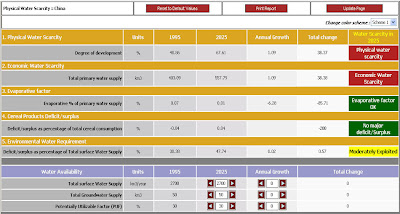By 2025, 1.8 billion people will live in countries or regions facing absolute water scarcity. Most countries in the Middle East and North Africa can be classified as being water scarce today. By 2025, these countries will be joined by Pakistan, South Africa, and large parts of India and China. This means that they will not have sufficient water resources to maintain their current level of per capita food production from irrigated agriculture—even at high levels of irrigation efficiency—and also to meet reasonable water needs for domestic, industrial, and environmental purposes. To sustain their needs, water will have to be transferred out of agriculture into other sectors, making these countries or regions increasingly dependent on imported food.
This web-based Model has been developed by The International Water Management Institute (IWMI), as part of the World Water Council Vision 2025 exercise. It builds on earlier research on food and water demands by IWMI. (Seckler et al, 1998. Water Supply and Demand 1990-2025: Scenarios and Issues, IWMI Research Report 19, International Water Management Institue, Colombo, Sri Lanka.)
The model computes current and future food and water demands for the year 2025, based on trends derived from FAO statistics (FAOSTAT) and user definable scenarios of population growth, changing diets and improvements in agricultural productivity and/or water efficiency.
The model determines, at national scale, water demand by the various sectors , including agricultural, industrial and domestic uses and environmental requirements. Designed as an interactive tool, PODIUM helps users to explore the implications of policy options, allowing assumptions to be modified and alternative future scenarios to be evaluated. The model does not produce definitive predictions but rather enables analysis of "what-if" questions.
Above picture shows the “easy-to-use” Cereal Requirements Calculator modules of the Model.
Above picture shows the SUMMARY of the predicted results for any selected country.

